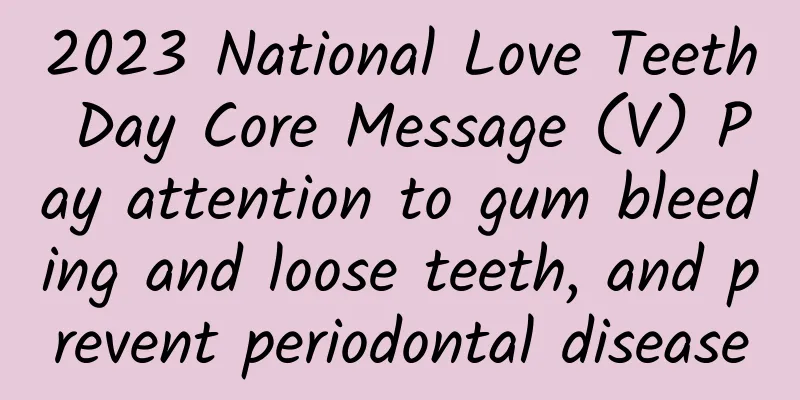2023 National Love Teeth Day Core Message (V) Pay attention to gum bleeding and loose teeth, and prevent periodontal disease

|
Author: Wang Sisi Siyan, Peking University School of Stomatology Periodontal disease is one of the most common diseases that affect oral health. It is a disease that occurs in the supporting tissues around the teeth. A schematic diagram of the periodontal tissue is shown in Figure 1. Figure 1 Schematic diagram of periodontal tissue A healthy tooth is like a big tree, and the gums and alveolar bone surrounding the tooth are like the soil around the tree roots. Adverse environmental factors will cause soil erosion, expose the tree roots, and even cause the tree to tilt and collapse. Similarly, if bacteria and tartar on the tooth surface are not removed in time, it will cause the gums to recede and the alveolar bone to be absorbed, just like soil erosion on a big tree, which will eventually cause the teeth to loosen or even fall off (Figure 2). Figure 2 Periodontal disease is like "soil erosion" Generally speaking, periodontal disease mainly includes gingivitis and periodontitis. Gingivitis is milder, while periodontitis is more serious. If gingivitis is not controlled, it may further develop into periodontitis. Gingivitis can cause red and swollen gums (Figure 3), bleeding gums (Figure 4), bad breath, etc. Normal gums are pink, thin and close to the teeth. When the gums are inflamed, they are bright red or even dark red, and become soft and enlarged. People with gingivitis often find that their gums bleed when they brush their teeth or bite hard objects. It should be noted that bleeding gums are a dangerous sign of unhealthy gums. If you find bleeding gums, you need to see a doctor in time. In addition, gingivitis is often accompanied by bad breath, which affects people's social interactions. Figure 3 Red and swollen gums Figure 4 Gingival bleeding (arrow points) In addition to symptoms such as red, swollen and bleeding gums and bad breath, periodontitis can also cause the gums to form a "bag" around the teeth due to inflammation. This is the periodontal pocket. Pus will also form a "periodontal abscess" (Figure 5) in the "bag", causing pain, bad breath, etc. Patients with periodontitis often experience gum atrophy, exposed tooth roots, and teeth that appear to be getting longer and longer. This is because the alveolar bone that supports the teeth is absorbed due to inflammation. Teeth that lose the support of the alveolar bone will become loose and shift (Figure 6), causing patients to feel that the gaps between teeth have become larger, affecting their appearance. As periodontitis progresses, the alveolar bone is constantly absorbed, and there is less and less bone supporting the teeth. The teeth become looser and less powerful when biting. When periodontitis develops further, the teeth may even become loose and fall off naturally, affecting facial shape and chewing. Figure 5 Periodontal abscess (arrow points) Figure 6 Gum recession, exposed tooth roots, and tooth displacement If gingivitis is treated in time, the bacteria and tartar on the teeth are removed, and daily cleaning is done, the gingival inflammation will be eliminated, and the shape and texture of the gums can return to normal. Therefore, gingivitis is reversible. However, once it develops into periodontitis, even if the bacteria and tartar are removed through treatment, just as it is difficult to restore the soil after soil erosion, the absorbed alveolar bone and receded gums are difficult to grow back. Treatment can only be used to stop the progression of inflammation and prevent greater damage (Figure 7, Figure 8). Therefore, periodontitis is irreversible. Figure 7 Before periodontal treatment Figure 8 After periodontal treatment Among the elderly, periodontal disease is the main cause of tooth loss. Therefore, if the elderly have problems such as red and swollen gums, bleeding, bad breath, loose and displaced teeth, they need to be vigilant, seek medical treatment in time, actively treat periodontal disease, and try to retain natural teeth. It is recommended that the elderly have regular oral examinations to detect and treat periodontal disease early. The earlier the treatment, the more periodontal tissue can be retained. Elderly people who have received periodontal treatment also need regular check-ups to maintain the treatment effect. |
Recommend
How long can bayberry be refrigerated? What are the benefits and taboos of bayberry?
Bayberry is rich in nutritional value. Eating it ...
What happens if there is brown blood before menstruation?
Menstruation is one of the physiological phenomen...
Why is the leucorrhea so thin?
Women not only experience menstruation every mont...
What causes vulvar itching after menstruation?
I believe that many female friends will experienc...
What is the problem of increased and thinning leucorrhea?
The normal and healthy leucorrhea of women is c...
Eating meat and eating dinner too late can increase cardiovascular risk
I am busy with work now, and my family only has t...
How is vaginal ultrasound performed?
Many women need to undergo professional examinati...
What to do if you have back and leg pain during breastfeeding
Breastfeeding is the stage when a woman has her l...
Beautiful youth, fighting acne with tricks
As the saying goes, "Youth is not without ac...
Do you understand these points about how women maintain their age?
Women love beauty more than men, so they care mor...
How can I slow down the progression of myopia? Will myopia continue to increase after adulthood?
With the increasing frequency of use of electroni...
The physiological effects of progesterone are
Estrogen, also known as progesterone, plays a ver...
Progesterone dosage
Luteal copper is often used in clinical medicine ...
Sri Lanka, Mauritius or Brunei, which one is more fun? What is the traditional industry of the Mauritians?
Mauritius is known as the pearl of the Indian Oce...









